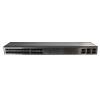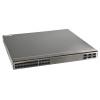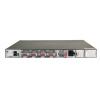-
$



CloudEngine S6730-S series full-featured 10 GE switches are Huawei's new generation fixed switches ,to provide 10 GE downlink ports as well as 40 GE uplink ports.
CloudEngine S6730-S can be used to provide high-speed access for 10 Gbit/s access to high-density servers or function as a core/aggregation switch on a campus network to provide 40 Gbit/s rate. In addition, CloudEngine S6730-S provides a wide
variety of services, comprehensive security policies, and various QoS features to help customers build scalable, manageable, reliable, and secure campus and data center networks.
- 24 x 10 Gig SFP+, 6 x 40 Gig QSFP+
- Dual pluggable power modules, equipped power modules by default not available
- Forwarding performance: 490Mpps
- Switching capacity: 960Gbps/2.4Tbps
Abundant Convergence
The CloudEngine S6730-S series supports SVF and functions as a parent switch. With this virtualization technology, a physical network with the "Small-sized core and aggregation switches + Access switches " structure can be virtualized into a "super switch", greatly simplifying network management.
The CloudEngine S6730-S series provides excellent QoS capabilities and supports queue scheduling and congestion control algorithms. Additionally, it adopts innovative priority queuing and multi-level scheduling mechanisms to implement finegrained scheduling of data flows, meeting service quality requirements of different user terminals and services.
Providing Granular Network Management
The CloudEngine S6730-S series uses the Packet Conservation Algorithm for Internet (iPCA) technology that alters the traditional method of using simulated traffic for fault location. iPCA technology can monitor network quality for any service flow anywhere, anytime, without extra costs. It can detect temporary service interruptions in a very short time and can identify faulty ports accurately. This cutting-edge fault detection technology turns "extensive management" to "granular management."
The CloudEngine S6730-S series supports Two-Way Active Measurement Protocol (TWAMP) to accurately check any IP link and obtain the entire network's IP performance. This protocol eliminates the need of using a dedicated probe or a proprietary protocol.
Flexible Ethernet Networking
In addition to traditional Spanning Tree Protocol (STP), Rapid Spanning Tree Protocol (RSTP), and Multiple Spanning Tree Protocol (MSTP), the CloudEngine S6730-S series supports Huawei-developed Smart Ethernet Protection (SEP) technology and the latest Ethernet Ring Protection Switching (ERPS) standard. SEP is a ring protection protocol specific to the Ethernet link layer, and applies to various ring network topologies, such as open ring topology, closed ring topology, and cascading ring topology. This protocol is reliable, easy to maintain, and implements fast service switching within 50 milliseconds. ERPS is defined in ITU-T G.8032. It implements millisecond-level protection switching based on traditional Ethernet MAC and bridging functions.
The CloudEngine S6730-S series supports Smart Link and Virtual Router Redundancy Protocol (VRRP), which implement backup of uplinks. One CloudEngine S6730-S switch can connect to multiple aggregation switches through multiple links, significantly improving reliability of access devices.
Intelligent Stack (iStack)
The CloudEngine S6730-S series supports the iStack function that combines multiple switches into a logical switch. Member switches in a stack implement redundancy backup to improve device reliability and use inter-device link aggregation to improve link reliability. iStack provides high network scalability. You can increase a stack's ports, bandwidth, and processing capacity by simply adding member switches. iStack also simplifies device configuration and management. After a stack is set up, multiple physical switches can be virtualized into one logical device. You can log in to any member switch in the stack to manage all the member switches in it.
Cloud-based Management
The Huawei cloud management platform allows users to configure, monitor, and inspect switches on the cloud, reducing on-site deployment and O&M manpower costs and decreasing network OPEX. Huawei switches support both cloud management and on-premise management modes. These two management modes can be flexibly switched as required to achieve smooth evolution while maximizing return on investment (ROI).
VXLAN
VXLAN is used to construct a Unified Virtual Fabric (UVF). As such, multiple service networks or tenant networks can be deployed on the same physical network, and service and tenant networks are isolated from each other. This capability truly achieves 'one network for multiple purposes'. The resulting benefits include enabling data transmission of different services or customers, reducing the network construction costs, and improving network resource utilization.
The CloudEngine S6730-S series switches are VXLAN-capable and allow centralized and distributed VXLAN gateway deployment modes. These switches also support the BGP EVPN protocol for dynamically establishing VXLAN tunnels and can be configured using NETCONF/YANG.
OPS
Open Programmability System (OPS) is an open programmable system based on the Python language. IT administrators can program the O&M functions of a switch through Python scripts to quickly innovate functions and implement intelligent O&M.
Big Data Powered Collaborative Security
Agile switches use NetStream to collect campus network data and then report such data to the Huawei Cybersecurity Intelligence System (CIS). The purposes of doing so are to detect network security threats, display the security posture across the entire network, and enable automated or manual response to security threats. The CIS delivers the security policies to the Agile Controller. The Agile Controller then delivers such policies to agile switches that will handle security events accordingly. All these ensure campus network security.
The CloudEngine S6730-S series supports Encrypted Communication Analytics (ECA). It uses built-in ECA probes to extract characteristics of encrypted streams based on NetStream sampling and Service Awareness (SA), generates metadata, and reports the metadata to Huawei Cybersecurity Intelligence System (CIS). The CIS uses the AI algorithm to train the traffic model and compare characteristics of extracted encrypted traffic to identify malicious traffic. The CIS displays detection results on the GUI, provides threat handling suggestions, and automatically isolates threats with the Agile Controller to ensure campus network security.
The CloudEngine S6730-S series supports deception. It functions as a sensor to detect threats such as IP address scanning and port scanning on a network and lures threat traffic to the honeypot for further checks. The honeypot performs indepth interaction with the initiator of the threat traffic, records various application-layer attack methods of the initiator, and reports security logs to the CIS. The CIS analyzes security logs. If the CIS determines that the suspicious traffic is an attack, it generates an alarm and provides handling suggestions. After the administrator confirms the alarm, the CIS delivers a policy to the Agile Controller. The Agile Controller delivers the policy to the switch for security event processing, ensuring campus network security.
Intelligent O&M
The CloudEngine S6730-S series provides telemetry technology to collect device data in real time and send the data to Huawei campus network analyzer CampusInsight. The CampusInsight analyzes network data based on the intelligent fault identification algorithm, accurately displays the real-time network status, effectively demarcates and locates faults in a timely manner, and identifies network problems that affect user experience, accurately guaranteeing user experience.
The CloudEngine S6730-S series supports a variety of intelligent O&M features for audio and video services, including the enhanced Media Delivery Index (eMDI). With this eDMI function, the CloudEngine S6730-S series can function as a monitored node to periodically conduct statistics and report audio and video service indicators to the CampusInsight platform. In this way, the CampusInsight platform can quickly demarcate audio and video service quality faults based on the results of multiple monitored nodes
Intelligent Upgrade
Switches support the intelligent upgrade feature. Specifically, switches obtain the version upgrade path and download the
newest version for upgrade from the Huawei Online Upgrade Platform (HOUP). The entire upgrade process is highly automated and achieves one-click upgrade. In addition, preloading the version is supported, which greatly shortens the upgrade time and service interruption time.
The intelligent upgrade feature greatly simplifies device upgrade operations and makes it possible for the customer to upgrade the version independently. This greatly reduces the customer's maintenance costs. In addition, the upgrade policies on the HOUP platform standardize the upgrade operations, which greatly reduces the risk of upgrade failures.
Product Specifications
| S6730-S24X6C | |
| Fixed ports |
24 x 10 Gig SFP+, 6 x 40 Gig QSFP+ |
| Dimensions (W x D x H) | 442 x 420 x 43,6 mm |
| Chassis height(U) | 1 U |
| Input voltage |
Rated AC voltage: 100V to 240V AC; 50/60 Hz Max. AC voltage: 90V to 290V AC; 45–65 Hz |
| Input current |
600 W Maks. 8 A |
| Maximum power consumption | 225 W |
| Minimum power consumption | 88 W |
| Storage temperature | Od -40 do 70 st. C |
| Noise (sound pressure at normal temperature) |
52 dB |
| Surge protection specification | ±6kV |
| Relative humidity | 5% to 95% (non-condensing) |
| Heat dissipation | Heat dissipation with fan, intelligent fan speed adjustment |
| Service Features | |
|---|---|
| MAC |
Up to 64K MAC address entries |
| VLAN |
4K VLANs |
| ARP |
Static ARP |
| IP routing |
Static routes, RIP v1/2, RIPng, OSPF, OSPFv3, IS-IS, IS-ISv6, BGP, BGP4+, ECMP, routing |
| Interoperability |
VLAN-Based Spanning Tree (VBST), working with PVST, PVST+, and RPVST |
| Ethernet loop protection |
RRPP ring topology and RRPP multi-instance Smart Link tree topology and Smart Link multi-instance, providing millisecond-level protection |
| IPv6 features |
Neighbor Discover (ND) |
| Multicast |
IGMP v1/v2/v3 snooping and IGMP fast leave |
| QoS/ACL |
Rate limiting in the inbound and outbound directions of a port |
| Security |
Hierarchical user management and password protection HTTPS |
| Reliability |
LACP |
| VXLAN |
VXLAN functions, VXLAN L2 and L3 gateways, BGP EVPN |
| SVF |
Acting as the parent node to vertically virtualize downlink switches and APs as one device for |
| iPCA | Marking service packets to obtain the packet loss ratio and number of lost packets in real time Measurement of the number of lost packets and packet loss ratio on networks and devices |
| Management and maintenance |
Cloud-based management |






 Polski
Polski English
English Italiano
Italiano Español
Español Čeština
Čeština Српски
Српски Deutsch
Deutsch Ελληνικά
Ελληνικά Slovenský
Slovenský




